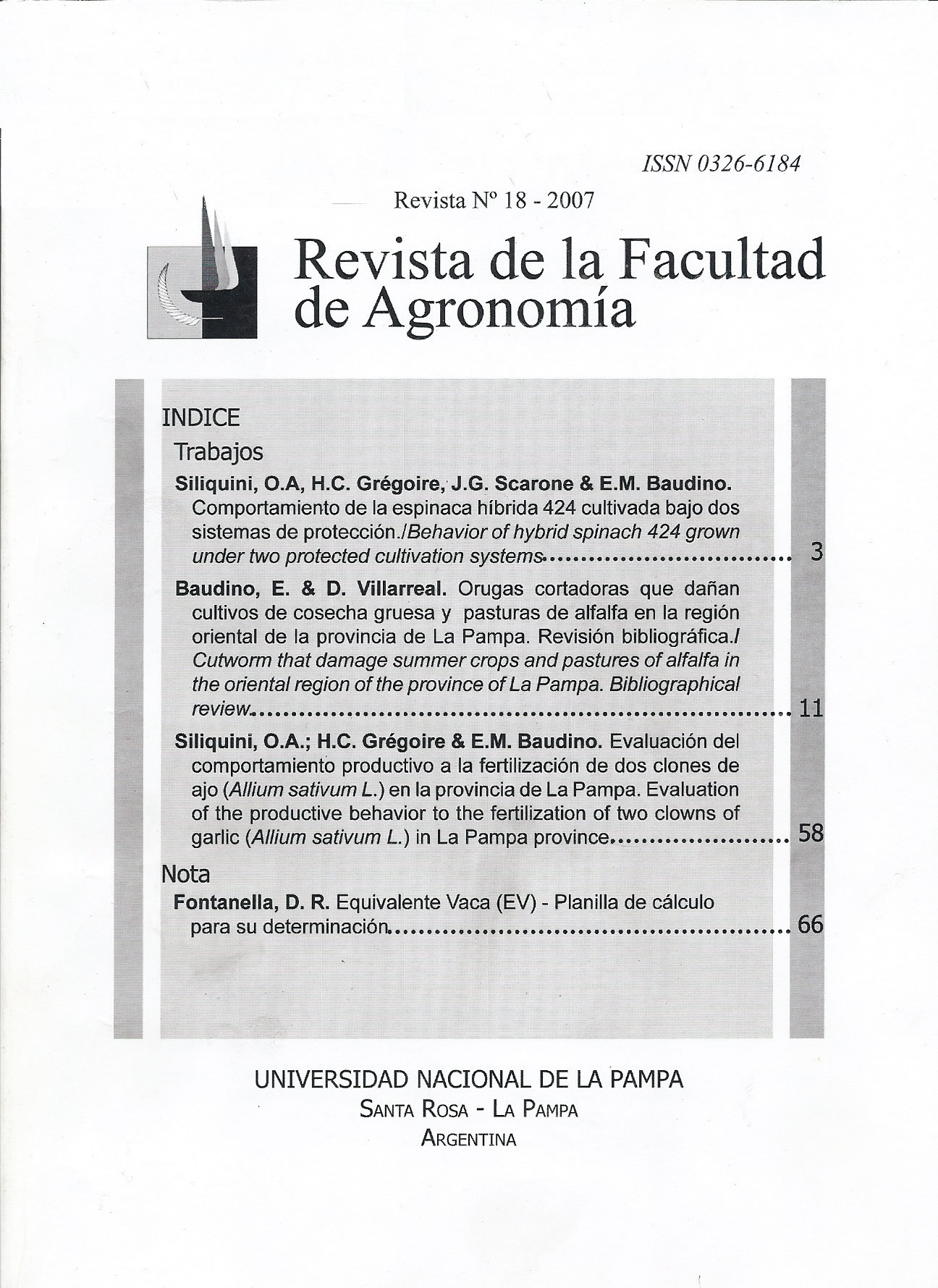Behavior of hybrid spinach 424 grown under two protected cultivation systems
Keywords:
Spinacea oleracea L., thermal cover, polyethylene tunnels, transparent polyethyleneAbstract
Spinach (Spinacea oleracea L.), is an important species among the leaf vegetable crops, and one of the most common winter crops developed by growers in the semi-arid region of the pampas, either in greenhouses or directly in the fields. As a plant of cold temperate climate, it can stand low temperatures of up to - 5° C. In our region temperatures can still be lower, influencing the stage of major development of the plant, what makes it necessary to counterbalance the effect of frost, resorting to protected cultivation systems. The aim of this work was to analyze and assess the behavior of two protected cultivation systems in the fields, and their response in terms of production. Two protected cultivation techniques were contrasted, namely polyethylene tunnels (T1) and thermal cover (T2) with a control crop without protection (T0). The experiment was carried out in the vegetable garden of the Faculty of Agronomy, National University of La Pampa using a randomized block design with 3 treatments and 4 replications. The plots, 5 m. long and 0.50 m. between rows, were seeded with a Hybrid 424 on April 15* 2003, using a row-crop seeder of vertical plate. Thinning was performed twenty days after sowing; spacing between plants was 0.10 m. on the sowing line, with a density of 20 plants.m2 After emergence, all treatments were fertilized with 100 Kg.ha-1 urea. The harvest for treatments T1 and T2 was on July 7th 2003 and for T0 on July 30* 2003. ANOVA, performed according to Tukey's Test, showed significant differences in T1 and T2 with respect to T0. no differences were observed between T1 and T2 The current values in which the spinach is commercialized, it makes it very profitable cultivated in both systems of protection. The high prices obtained by this vegetable are due to the distance with regard to producing traditional zones.
Downloads
References
Maroto, J. V. 1995. Horticultura Herbácea Especial. Editorial Mundi- Prensa. Madrid España.
Nakama, M.1988. Comportamiento de híbridos y variedades de espinaca (Spinacea olerácea) en la región Litoral Bonaerense. XI Congreso Argentino de Horticultura. Mendoza. Argentina.
Siliquini, O. A; Grégoire, H. C.; Scarone, J. G. 2000. Evaluación de comportamiento productivo del cultivo de espinaca y su respuesta a la fertilización nitrogenada en la Región Semiárida Pampeana. XXIII Congreso Argentino de Horticultura. Mendoza. Revista Produciendo N° 68, Año Vil 2001. ARGENTINA.
Stoppani, M; Soria, A; Boy, A. 1997. Espinaca. Evaluación de cultivares e híbridos para procesamiento industrial. XX Congreso Argentino de Horticultura. Bahía blanca, Bs. As. ARGENTINA.
Vergara, G. T; Casagrande, G. A. 2003. Datos obtenidos en la Estación Climática de la cátedra de Climatología y Fenología Agrícola de la Facultad de Agronomía, UNLPam, Santa Rosa, La Pampa, ARGENTINA.
Downloads
Published
Issue
Section
License
La Editorial de la Universidad Nacional de La Pampa (EdUNLPam) exigirá a los/as autores/as la firma del siguiente documento:
La EdUNLPam lleva a cabo la publicación del artículo: (Título del Artículo) en SEMIÁRIDA Rev.Fac.Agron UNLPam ISSN 2362-4337 (impresa) ISSN 2408-4077 (en línea), del cual el/los abajo firmantes son autores de una o más partes. En el mismo acto, el/los autores entregan exclusivamente a la EdUNLPam todos sus derechos protegidos por las leyes de propiedad intelectual que rigen en la Argentina para reproducir, publicar, editar, fijar, comunicar y transmitir públicamente en cualquier formato o medio impreso o electrónico, inclusive internet, el artículo enviado a publicación e incluirlo en índices o bases de datos nacionales e internacionales. A cambio, la EdUNLPam entrega a los autores la autorización para la publicación o reimpresión con ines académicos y educativos en cualquier libro o medio de divulgación, con la sola obligación de citar el artículo original publicado en la EdUNLPam. Cada autor acuerda en que el material provisto a la EdUNLPam es un trabajo original, que no ha sido impreso o publicado en cualquier otro medio con anterioridad y que no vulnera derechos de terceros. El Primer autor tendrá la posibilidad de leer y corregir el artículo ya editado como “prueba de galera”, pero si el autor no devolviera esas correcciones de la prueba de galera dentro del tiempo especificado, el proceso de producción y publicación podrá proseguir sin la aprobación del autor. El/los autor/es no recibirán compensación monetaria de la EdUNLPam por el uso del material contenido en este artículo y asumen la responsabilidad de las opiniones vertidas en él.






.png)



22.png)



.jpg)




.jpg)
